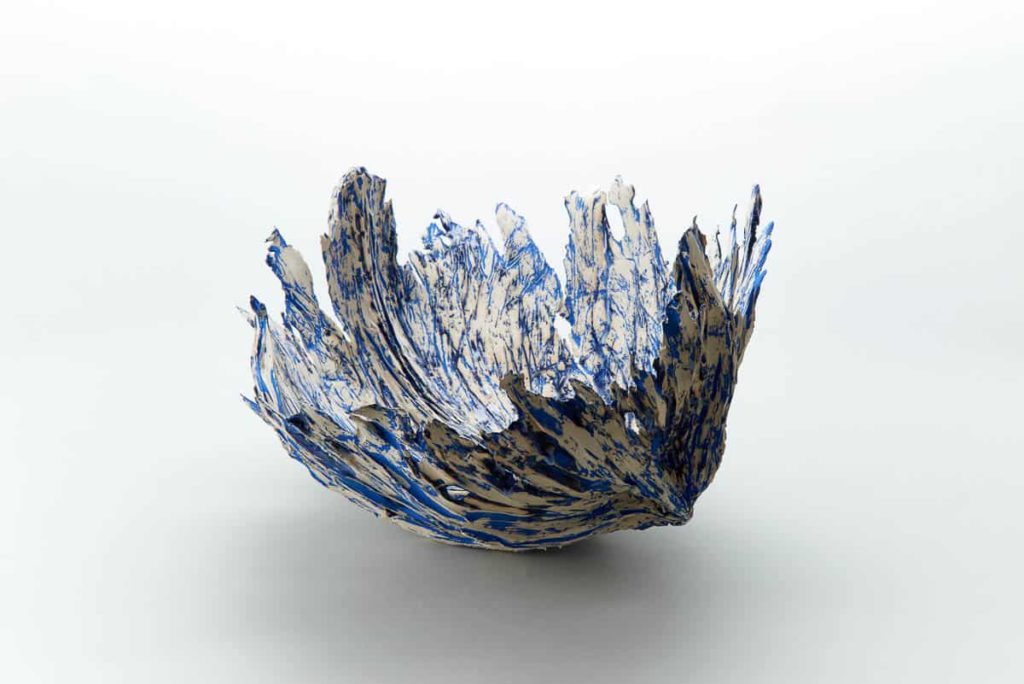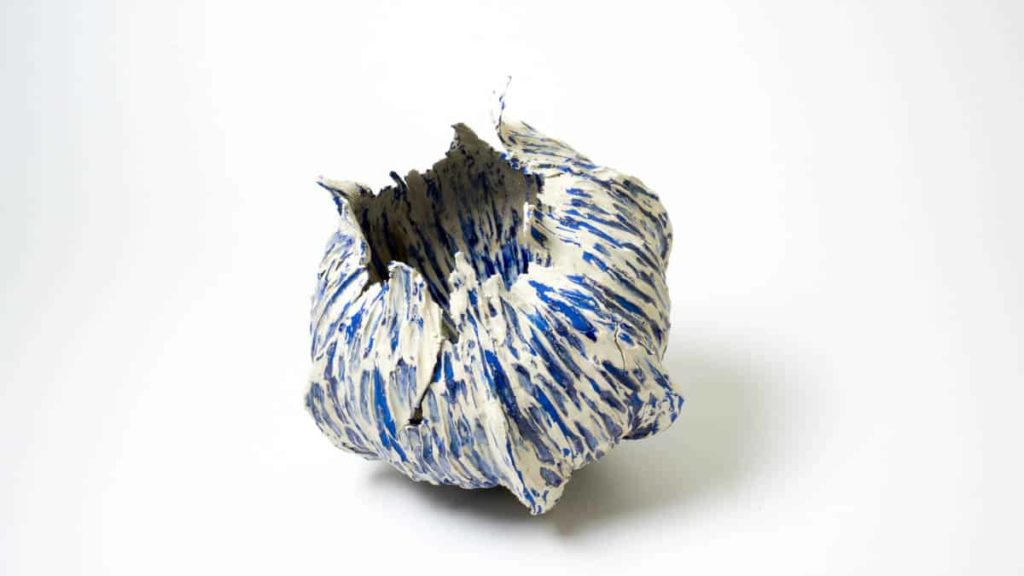A ceramist, Machiko Hashimoto, has her home and studio in Fushimi, Kyoto. She makes a wide range of zaffer (Gosu, cobalt oxide paint)-based pieces from sculptures to everyday dishes. Among them are her flower works with zaffer portraying the life of a flower. They are highly esteemed at home and abroad. These artworks have both gorgeous and ephemeral feelings. Unlike real flowers, their thin petals with fine cuts are likely to “break easily” as they are made of semi-porcelain. At the same time, their boldly carved surface attracts you together with their flowery shape. Now Machiko Hashimoto has taken up the flower series for the first time since she made them for her solo show at Sokyo Gallery in 2014. Sokyo Gallery asked her about her thoughts on creating works, including how her delivery experience, one of the biggest life events, made an impact on her.
Making process
- Michiko Hashimoto, checking how dry they are after carving them
- The process of carving the works
- Carving tools
How long does it take you to create an artwork? Would you explain the process of works?
It takes me about two months including a planning stage. I can make two pieces in a kiln at one time. It takes me one day to build slab. I add carving to both inner and outer sides one by one. First, I place artworks on a beach ball or Styrofoam form to add carving on the outer side. I use ten kinds of tools for carving. I finish carving quickly and dry them in one day while keeping their rounded shape. The process of drying often depends on the weather. Then, I turn over the artworks and form the inside and add carving to the inner side before they dry. After completely drying them for two weeks, I fire them unglazed. Finally, I colour them by zaffer (Gosu) and fire them in a kiln again.
What kind of clay do you use? Can you share the process of how you found the clay with us?
I have used semi-porcelain clay for Shigaraki ware since I was an art student. I don’t blend clay for myself but buy it. First, I used white clay for a while, but I felt it was better to use semi-porcelain clay for the white and pointed (togatta) parts of the flower works, so I have begun to use it instead.
Sources of Inspiration
You are born in Kyoto and are still based in Kyoto now. Does Kyoto have any impact on your works? And if so, what kind of impact do you think Kyoto has on your works?
I was born and raised in Kyoto, and I still live in Kyoto. I am not so conscious of my connection to Kyoto, but I think Kyoto is deep-seated in myself and I am often told that I really look like I am from Kyoto. I like to go out and visit many places in Kyoto. In particular, I love water sites.
You have made your artworks based on the colours of blue and white. Do you have any reason for this?
First, blue is my favourite colour and I think blue is the colour of life. Blue reminds you of sky, sea, and water, and it has a strong image. Blue has been my favourite colour since I was little. I have wanted to make a blue ware since I was a little girl. I decided to use zaffer (Gosu) to let my works stand out compared to celadon works in which so many precursors specialised. Moreover, I mainly use zaffer to make my works because I got used to it, even as an art student.
What flowers are they? What are you expressing through the motif of flowers?
I began to make flower works when I wanted to capture the interesting moment when flowers are coming out. In my view, flowers symbolise life. The flowers in my artworks don’t express the image of certain flowers such as tulips but the image of imaginary flowers and even water crown splashing.
Thoughts on Creating Works
What do you want the beholders to find in your works? What thought do you put into your works?
My works remain still, but I would like the beholders to feel endless motion from my works. I express the energy by strong carving while expressing ephemeral beauty by thin spines.
I think the petals of the flowers are a little thicker compared to those of the previous flower series, which seem to give a different impression. Is there any reason for this change?
The previous works were sharper and more delicate. When I had an order of flower series, I remembered three years ago, the year of 2014. During making artworks, I looked back on what was inside of me back then, and I remember my heart was “spiny and delicate and going to break off”. Now that I am a mother, I have become calmer, more big-hearted, and less spiny.
At the end of the interview, Hashimoto said that she would like to improve her skills more to create whatever shape she likes to make. This interview showed that some progress and the reflection from an artist’s mind can be observed even in making artworks with the same motif. Seeing an artist change through her artworks can be the best part of looking at ceramic arts and collecting them. We appreciate you visiting Hashimoto’s solo exhibition, scheduled in August 2018 at Sokyo Gallery.
Sokyo Gallery was founded in 2013, Sokyo Gallery represents thirty-three artists in and out of Japan.The gallery is situated in Gion, an unspoilt, historic district of old Kyoto. The gallery handles work in ceramic, painting, photography and drawing.The gallery holds twelve exhibitions through a year and participates in international art fairs all over the world such as Design Basel, TEFAF Maastricht, Collect London and Art Taipei. In addition to the exhibitions and the art fairs, the gallery contributes public art projects which enlivens local communities. The gallery works with architects and interior designers to create artistic space for world-famous hotels, restaurants and department stores.






